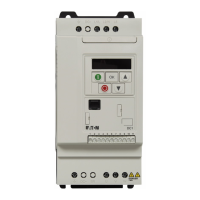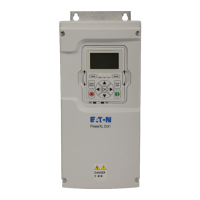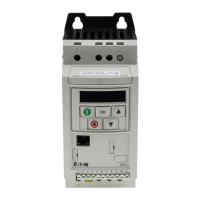6 Drives control
6.3 Motor
DC1 variable frequency drive 12/13 MN04020003Z-EN www.eaton.com 109
6.3.2 87-Hz Characteristic curve
In order to have the motor from Figure 16, page 39 run with an 87-Hz
characteristic curve, the parameters need to be configured as follows:
The motor must be in a delta configuration for this purpose. When this setup
is used, the motor will have a motor voltage of 230 V at a frequency of 50 Hz
and a motor voltage of 400 V at a frequency of 87 Hz. The field-weakening
range will start above 87 Hz.
Table 12 below shows which motor is needed for which mains voltage.
Table 12:Motor ratings for mains voltage for 87-Hz characteristic curve
P-01 87 Hz
P-07 400 V
P-08 3.2 A (
)
P-09 87 Hz
Part no. Mains voltage Motor
DC1-1D
DC1-12
DC1-32
230 V 127 V /230 V
DC1-34 400 V 230 V/400 V
PNU ID Access rights Value Description DS
RUN ro/rw
P-07 135 – rw 0.20 - 230/500 V Nominal motor voltage 230
(→ Motor rating plate)
Pay attention to the mains voltage and the type of circuit in the stator
winding!
Note:
This parameter has a direct influence on the V/Hz characteristic curve
(e.g. operation with the 87-Hz characteristic curve). This must be espe-
cially taken into account in the case of values (P-07) that deviate from
the variable frequency drive's rated operational data (U
LN
= 100%). This
may cause the over-excitation of the motor and thus lead to an
increased thermal load.
P-08
136 ✓ rw Depending on
device
Rated motor current 4.8
Setting range: 0.2 x I
e
-2x I
e
[A]
I
e
= variable frequency drive’s rated operational current
(→ Motor rating plate)
P-09
137 – rw 25 - 500 Hz Rated motor frequency 50.0
(→ Motor rating plate)
Note:
This parameter value is also automatically applied as the cut-off
frequency for the V/Hz characteristic curve.

